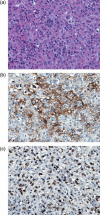Age-related Epstein-Barr virus-associated B-cell lymphoproliferative disorders: special references to lymphomas surrounding this newly recognized clinicopathologic disease
- PMID: 18429953
- PMCID: PMC11159301
- DOI: 10.1111/j.1349-7006.2008.00813.x
Age-related Epstein-Barr virus-associated B-cell lymphoproliferative disorders: special references to lymphomas surrounding this newly recognized clinicopathologic disease
Abstract
Epstein-Barr virus (EBV) is associated with some disease entities of malignant lymphomas, including Burkitt lymphoma, Hodgkin lymphoma, immunodeficiency-associated lymphoproliferative disorders (LPD), and a part of diffuse large B-cell lymphoma. We have recently identified a series of elderly patients with EBV-associated (or EBV(+)) B-cell LPD (B-LPD) showing similarities in many respects to immunodeficiency-associated LPD, although no evidence of underlying immunodeficiency was found. Therefore, the nosological category of senile or age-related EBV(+) B-LPD has been proposed for those patients. A larger series of patients with this disease revealed that the relative ratios of such EBV(+) B-LPD to all diffuse large B-cell lymphoma cases were higher with increasing with age, reaching a peak (20-30%) at > or =90 years of age, with a median of 71 years, providing additional evidence for our assertion that this disease may be related to immunological deterioration as a result of the aging process. This new disease entity is characterized pathologically by centroblasts, immunoblasts, and Hodgkin and Reed-Sternberg-like giant cells with a varying degree of reactive components, often posing therapeutic and diagnostic problems for hematologists and pathologists, respectively. The aim of the present review is to briefly summarize the overall clinicopathological profile of this newly recognized age-related (also called 'senile') EBV(+) B-LPD and EBV(+) Hodgkin lymphoma for a practical diagnostic approach.
Figures





References
-
- Jaffe ES, Harris NL, Stein H, Vardiman JW, eds. World Health Organization Classification of Tumours. Pathology and Genetics of Tumours of Haemotopoietic and Lymphoid Tissues. Lyon: IARC Press, 2001.
-
- Lymphoma Study Group of Japanese Pathologist . The World Health Organization classification of malignant lymphomas in Japan: incidence of recently recognized entities. Pathol Int 2000; 50: 696–702. - PubMed
-
- Gandhi MK, Tellam JT, Khanna R. Epstein–Barr virus‐associated Hodgkin's lymphoma. Br J Haematol 2004; 125: 267–81. - PubMed
-
- Park S, Lee J, Ko YH et al . The impact of Epstein–Barr virus status on clinical outcome in diffuse large B‐cell lymphoma. Blood 2007; 110: 972–8. - PubMed
-
- Oyama T, Ichimura K, Suzuki R et al . Senile EBV+ B‐cell lymphoproliferative disorders: a clinicopathologic study of 22 patients. Am J Surg Pathol 2003; 27: 16–26. - PubMed
Publication types
MeSH terms
LinkOut - more resources
Full Text Sources
Medical

